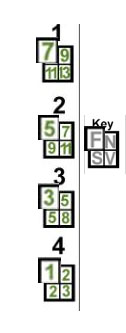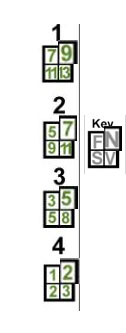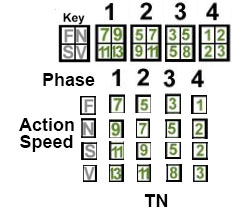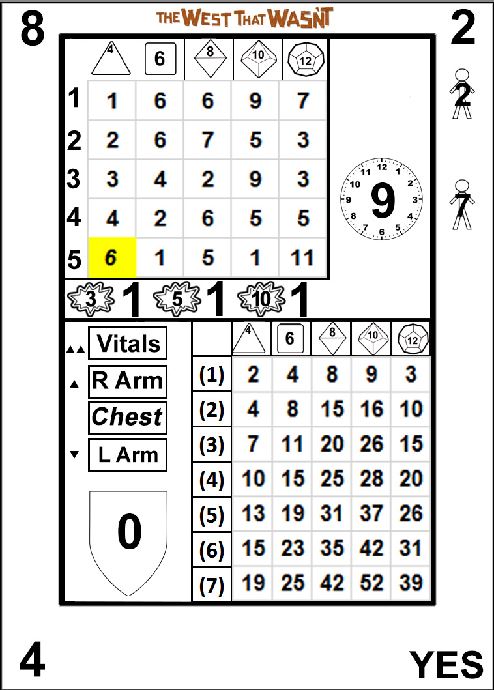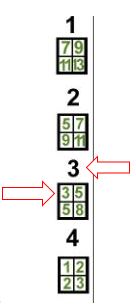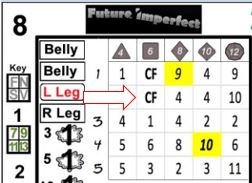Difference between revisions of "Future Imperfect - Initiative and Action Speeds"
(→Initiative Example, Antares Darkeye Runs From the Cops) |
(→Initiative Example, Antares Darkeye Runs From the Cops) |
||
| Line 152: | Line 152: | ||
[[image:8init-3.JPG]] | [[image:8init-3.JPG]] | ||
| − | When the Master calls out phase 3, Antares indicates he will run around the corner (a fast action). Because the officers got a CF result, they hesitate and do nothing this round. | + | When the Master calls out phase 3, Antares indicates he will run around the corner (a fast action). Because the officers got a CF result, they hesitate and do nothing this round. Being in the presence of notorious space pirate Antares Darkeye was clearly more than these troopers could handle. |
===Initiative Example 2, === | ===Initiative Example 2, === | ||
Revision as of 13:52, 24 March 2019
Whenever the game enters action time, speed and order of operations become important. Future Imperfect classifies actions in one of four speed categories: Fast, Normal, Below Average, and Slow. Action speeds are used to determine which actions happen first in each round. The initiative system has more on how to use action speeds to determine action sequence.
Contents
Action Time vs Narrative Time
Future Imperfect differentiates between action time and narrative time in the following manner. Narrative time is any time during the game when detailed timekeeping and movement is unnecessary. In narrative time, the passage of a few minutes, or even an hour or more, can be assumed to occur as necessary. It is likewise unnecessary to know the moment to moment location of characters and NPCs.
The most common usage for action time is combat, but it is also used for any encounter where time and relative placement of characters is crucial. In these situations, the order of operations has an immediate impact on the game world and the actions that follow.
Action Speeds
Future Imperfect uses the concept of action speed to determine the order of actions each round. This means that the speed of an action itself is more impactful on how quickly an action can be done, than the individual attempting the action. Each action has a classification, called action speed, that broadly defines how quick the action is to perform. Rather than using a trait of a character, modified by an action, Future Imperfect uses the speed of an action, modified by a character.
Example Action Speeds
The following list provides the speed of the most common actions that can be performed in a game. The list is not meant to be exhaustive, but it does cover most situations. The Master is the final authority regarding the speed of any action that is not listed here.
Fast Actions
Run
Some martial arts attacks
Fast weapons such as light pistols and knives
Normal Actions
Brawl
Move/Athletics
Use a skill at a -2 penalty
Weapons such as swords, carbines and heavy pistols
Below Average Actions
Use a skill
Weapons such as heavy rifles and two handed axes
Slow Actions
Extended action. Extended actions are complex skill checks requiring multiple victories to complete, or any other task that will take longer than one round.
Heavy weapons such as machineguns
Special Cases
Use item - by item
Ranged weapon - by weapon type.
Aimed shot - one slower than weapon speed. Slow weapons require an entire round to aim.
Hand to hand weapon - by weapon type.
Martial Arts - Special - Defined by art/maneuver type.
Example item speeds:
The previous image shows the traits for TL 7 lasers. In the Attributes column some have entries such as Fast, for the 3mm light pistol. This attribute is the action speed. Those without speed entries are considered normal.
Note: This image was created with the previous action speed categories, so the Slow entry means Below Average, and the Very Slow entry means Slow.
Determining Action Speed
If a character is performing a single action only, then the speed of that action is their action speed for the round. A single free action (see below) may also be considered part of another action with no penalty.
Combining Actions
If a character wishes to perform more than one action in a round, the character still has a single action speed for the round for initiative purposes. This speed is equal to the slowest of the actions attempted. There are some exceptions to this.
Two fast actions count as a single normal action when combined. Slow actions may not be combined with any other action. Otherwise, when combining actions your action speed is one level slower than your slowest action.
Examples: Chuk wishes to fire his Blast MMG, which is a slow action. He may not combine this with any other action.
Sid Scorpio is running and firing his laser pistol, both of which are fast actions. Because they are combined it counts as a normal action. His action speed for the round is normal.
Kayla Argent declares she will run (fast), fire a laser pistol (fast) and draw her stun baton (normal). Her two fast actions combine to count as normal, and her other action is also normal. Therefore, her action speed is below average.
Free Actions
Some actions are so quick that they are determined to be free. Each character may do one free action per round. Any further free actions count as a fast action. Some examples of free actions are talking (a sentence or two), giving a hand signal, and pressing a button (such as turning on a handheld device).
Initiative
In action time the order of actions is determined by the initiative system. What follows is a description of how to sequence action rounds.
Phases and Round Timing
Each action round is divided into four phases. All actions in the first phase occur before any actions in the second phase. After all four phases have resolved the round is over, and if necessary a new one is begun.
Determining Initiative
The following section describes the advanced initiative system. This involves two steps: declaration and resolution.
Declaration
At the beginning of the round, all characters that are participating in the action declare their intentions. Declarations occur in reverse order of Reflex. Ties are broken in favor of the Crew, if two Crew members are tied they can determine who declares first in whatever method they choose.
When making a declaration, the player indicates the speed of the action they wish to perform this round. No more specificity is required. The goal of the declaration is to define how quickly a character is acting during the round, not to force a decision before the situation has an opportunity to unfold. When their turn arrives, they may choose any action that has the declared speed or higher.
Examples
Antares Darkeye wishes to fire at one of the Kyr agents that is surrounding him. His blast pistol has an action speed of normal. He declares a normal speed action. He does not need to declare a target. When it is his turn to act, he can choose any target he wishes. He may also choose to do any action that has a higher action speed, such as running away (fast action).
Xenes declares he is moving swiftly (but not running) along a corridor (normal speed action). Before he acts, a GPR BRINT agent appears in the doorway in front of him. He may continue moving (normal) or fire with his laser pistol (fast), but he may not open the panel on the wall and attempt to hack the door controls and close the door between the agent and himself (below average).
Resolution
Once all characters have declared their speed for the round, flip a card and determine the initiative sequence. Each action card has an initiative bar on the left outer edge.
The key is marked on the top set of squares.
The key tells which square is used to determine the initiative number. For example, if the declared action speed is fast, use the upper left box (the F). Only the numbers in this box are relevant to the given action. The number is the TN to act in that phase.
To determine when the action occurs, use the cause grid to check Reflexes (see Future Imperfect - Action Cards for instructions). Compare the number to the given TN. The character can choose to act in any phase where their Reflex check meets or exceeds the TN. In the given key, a fast action would resolve in phase 1 on a 7+, phase 2 on a 5+, phase 3 on a 3+ and phase 4 on a 1+. If it were instead a slow action the TNs would be 11, 9, 5, 2 respectively. Once a character knows which phase they will act, place a counter on the given phase on their character sheet (or otherwise note the phase).
If a character does not generate a TN high enough to go in phase 4, the character hesitates and does not go this round. If the character chooses to do the same action again next round his action is considered one speed category faster.
If the Reflex result is CF, the character does not act this round, and get no bonus to speed next round. He is considered to hesitate, as above.
Reading the Initiative Bar
The initiative bar is a graphical table that shows the TN necessary for actions of a given speed to act in the given phase. The key, located above the bar on the card, shows which internal square relates to each given action speed. There are four boxes in the initiative bar, and each box is divided into four squares. The boxes are labelled with a number from 1-4. This indicates the phase this box represents. For example, the image below is for phase 1.
The given numbers within the box are the TN necessary for an action of that speed to occur in that phase. Consulting the key (arranged beside the bar for illustration purposes, below), this means that the number in the upper left, the 7, is the TN required to act in phase 1 with a fast action. If the action speed were slow, a 13 TN would be required to act in this phase. Once you have declared your action speed for the round, only the results in the appropriate square are used to determine action timing. Recall action card concept 1: use what you need, ignore everything else.
For example, if you declare a fast action, only the following information is relevant:
Note that the placement of the F in the key corresponds to the highlighted squares in the bar. This is how the key is used. In this case, it highlights that the TN for the rounds 4-1 are 1, 3, 5, 7 respectively.
If the declared action had been normal, this is how the key is read.
In this case, the N in the key indicates the upper right hand square. The TNs are 2, 5, 7, 9 for phases 4-1, respectively.
The arrangement of the key and initiative bar is not intuitive for many. There is a reason for this: it is not arranged in the most visually obvious manner. Then why is it arranged this way? The simple answer is space. To fit the information on the card, in the given space, required finding an arrangement that was both consistent and clear (once grasped, that is).
In this graphic the elements from the key and bar are rearranged (like a ransom note from an 80s Dirty Harry flick) in what is a more commonly utilized format. This image should clarify the intent behind the key, and also elucidate why the information had to be displayed in the chosen format. Once the layout is understood, the key and bar are easy to reference.
NOTE: The key shows the old action speeds, F, N, S, V, which correspond to the current speeds of F, N, B, S.
Taking Actions
Once all characters have determined in which phase they will act, the round begins in phase 1. The Master calls out phase 1 and all characters who will go in that phase indicate such. If there are multiple characters going in a phase, ties are broken based on Reflex, in favor of larger dice, then number of dice. Ties that persist are broken in favor of the Crew.
When a character has an action, they may perform any action they choose as long as the action speed of the given action is equal to or faster than the speed they declared. This allows characters to react to a changing scene, while still needing to use planning and strategy during the declaration phase.
Repeat the process for phases 2-4. Once they are complete, the round ends. If another round is necessary, start again from the top.
Initiative Example, Antares Darkeye Runs From the Cops
Antares Darkeye is attempting to escape from two IPA officers with laser pistols. Antares has 2d10 Reflexes, while the IPA officers each have 2d6. Therefore, the officers must declare first. Each declares that they will attempt a fast action. Antares also declares a fast action.
The initiative card is drawn.
Antares gets 4...rats.
According to the initiative key, fast actions use the upper left box. He goes in phase 3 (his generated result, 4, is at least 3, for phase 3, but less than 5, for phase 2).
Luckily for him, the officers get CF.
When the Master calls out phase 3, Antares indicates he will run around the corner (a fast action). Because the officers got a CF result, they hesitate and do nothing this round. Being in the presence of notorious space pirate Antares Darkeye was clearly more than these troopers could handle.
Initiative Example 2,
Simple Initiative
In some cases, the Master and Crew may decide to use a simpler initiative system. This system is suitable for short encounters or situations where the players do not want all of the detail of the standard initiative system. In the simple initiative system, actions are ordered by speed: all fast actions go in phase 1, all normal in phase 2 etc. Order within phases is determined by Reflex die type, then number of dice. If multiple characters remain tied their actions occur simultaneously.


